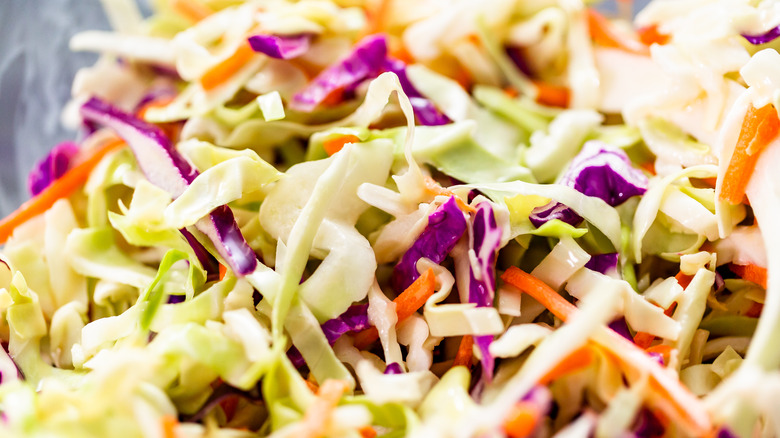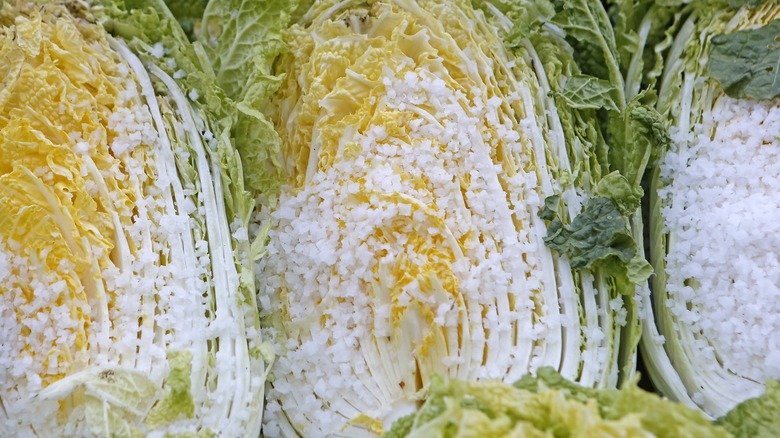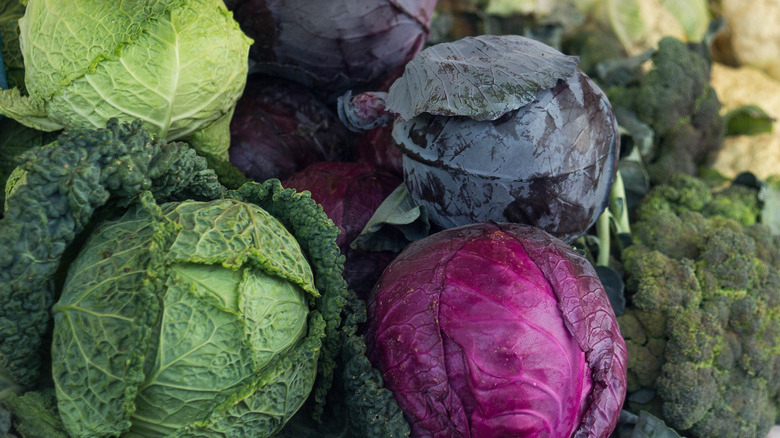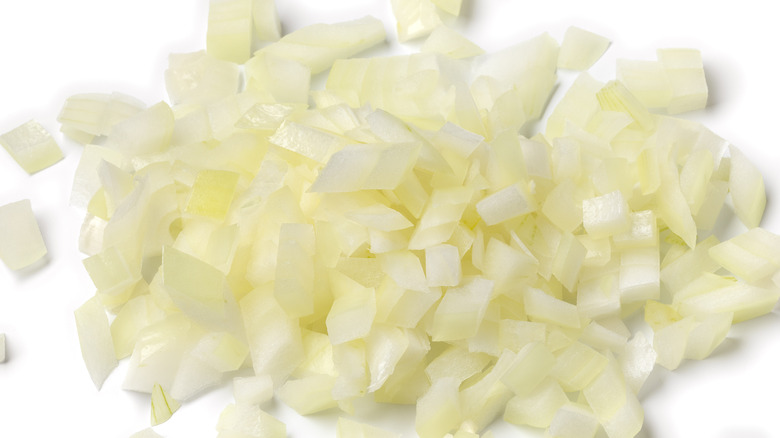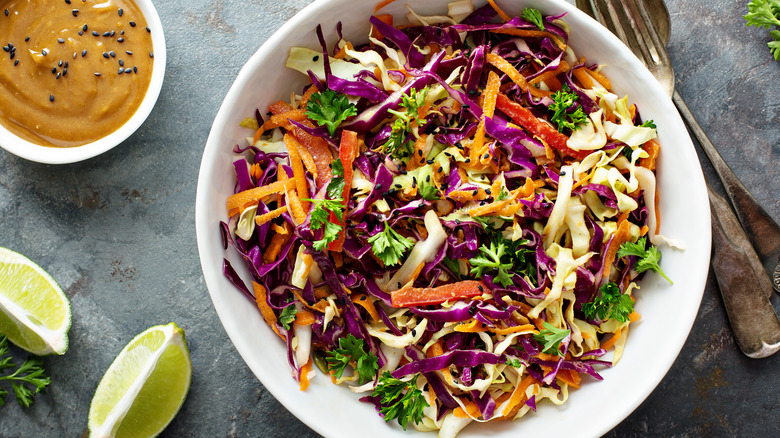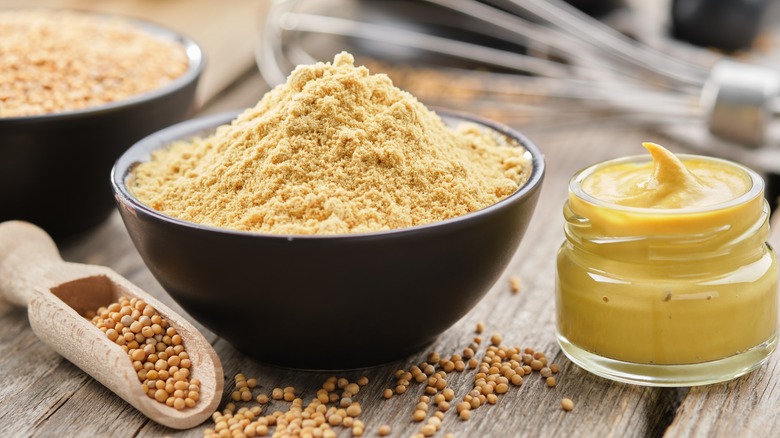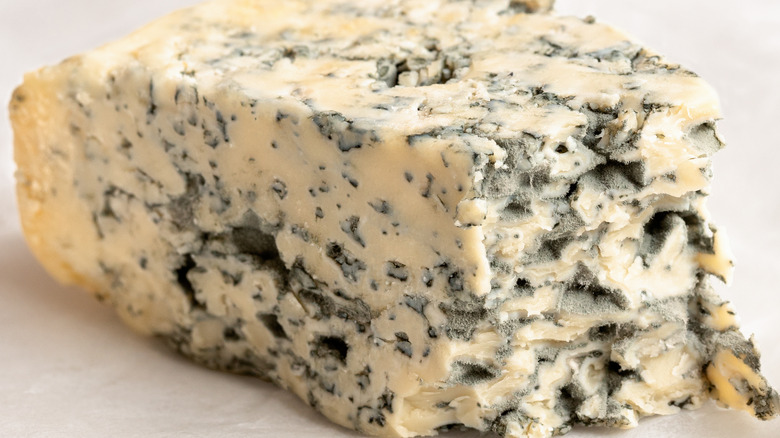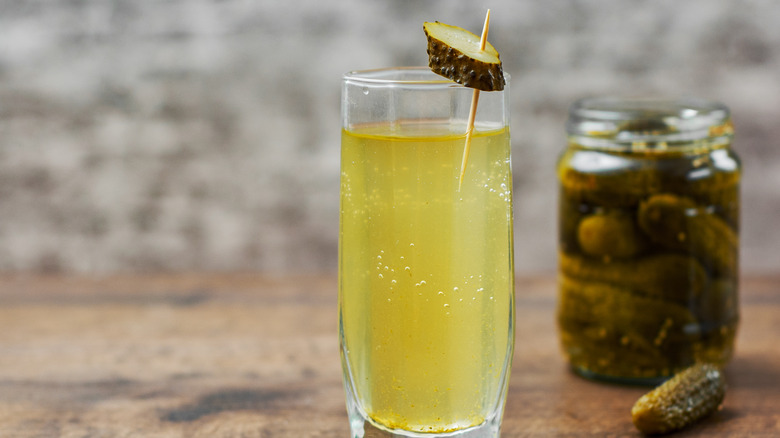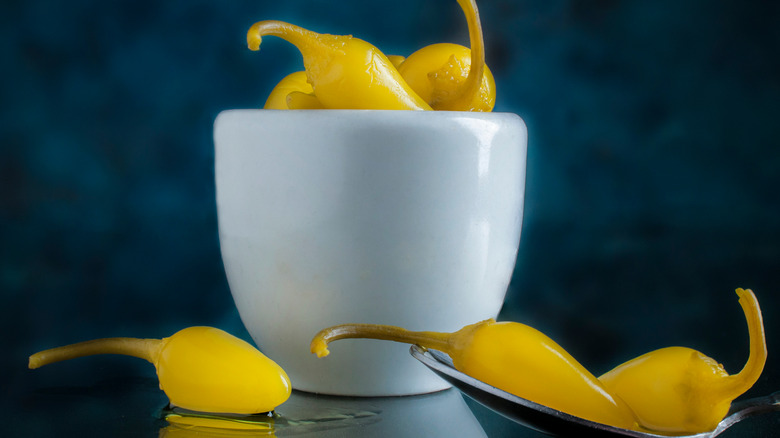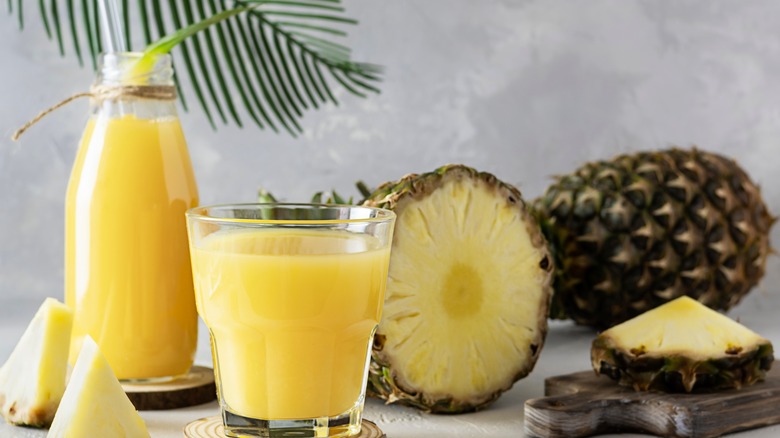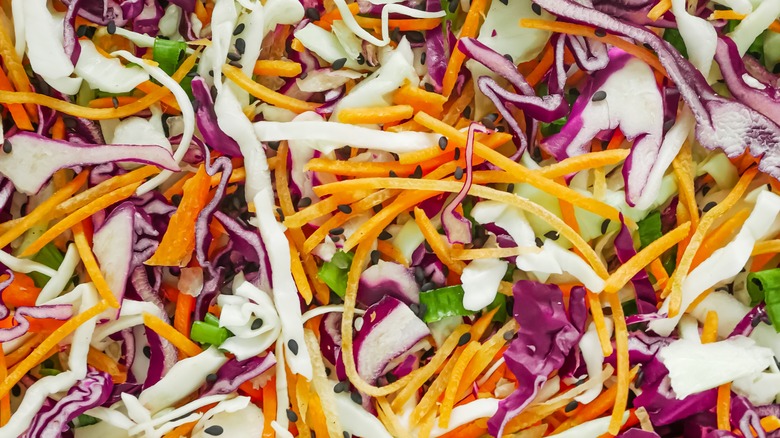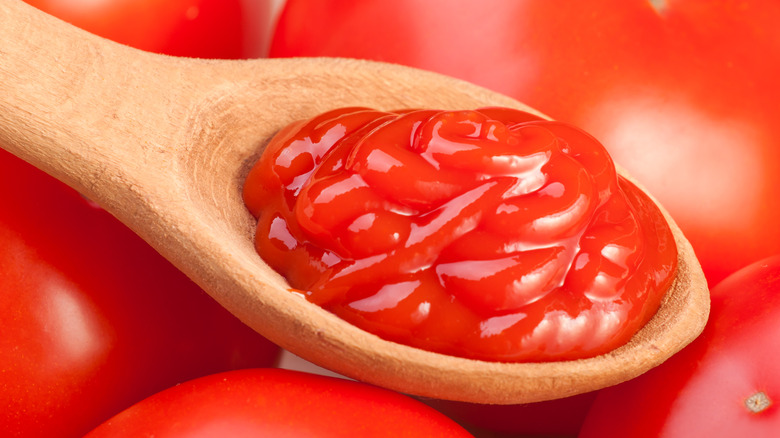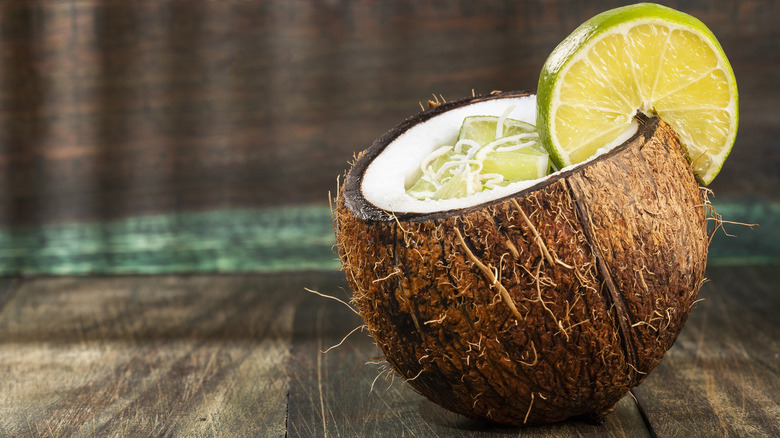13 Ways To Add More Flavor When Making Coleslaw
Coleslaw is a famously simple dish, with a name derived from the inauspicious Dutch koolsla, literally just meaning "cabbage salad." That hasn't stopped it from being an American staple, with plenty of regional variations developing across the U.S. as it went from an import to a local staple. While that simplicity can be deceptive, it presents myriad opportunities for the at-home gourmand to punch it up, and avoid the common issues that turn a coleslaw subpar.
Shredded cabbage tossed with dressing is only the start of what you can do with what looks like a wholly unassuming side dish. We're at least 200 years on since the salad's name was Anglicized, and that has given the world plenty of time to iterate, evolve, and play with various additions, enhancements, and whole new flavor profiles. From celebrity chefs to at-home experimenters, from out-of-print cookbooks to globe-bestriding fast food titans, we at Mashed went looking for the most effective and exciting methods for improving on the crunchy confetti. So for your next backyard barbecue, here's what we found.
1. Salt your cabbage
Salt has served us as a flavor enhancer for oh ... about 10,000 years, so it can be taken on faith that a pinch of salt can work its magic on cabbage. In fact, it's the first ingredient used in the process of making kimchi, the fermented cabbage dish from the Korean peninsula that's been a staple since long before Americans were putting cold cabbage alongside their ribs.
However, we're not prioritizing salt as a flavor booster here, but as a desiccant. Cabbage gets exposed to a lot of water, it needs that water to live, to grow, and to rinse off any dirt before it's served. But when cut, that water contained in all those crunchy leaves tends to leak out. Water leaving your shreds of cabbage creates two problems; it makes the cabbage wilt and lose its crunch, and it dilutes your dressing, turning it into a mess that runs right off the cabbage and into a sad little pool you'll see at the bottom of your bowl when you're done eating.
This problem gets worse when you realize that most coleslaw recipes involve letting the final product sit to chill in the fridge for hours, during which your moist coleslaw is essentially taking a cold shower, washing all that dressing off. So in comes the salt, which it's recommended you apply before dressing the coleslaw. Let it draw the water out of the assembled ingredients in a colander, let set, then dress to your heart's content.
2. Combine different kinds of cabbage
All cabbages come from distinct cultivars of the same plant, Brassica oleracea. In fact, a lot of vegetables do. Thousands of years of selective breeding and grafting have turned one plant into broccoli, cauliflower, collard greens, Brussels sprouts, and of course, countless types of cabbages. It's a classic maneuver to combine red and green cabbages in coleslaw, as recipe developer and registered dietician Kristen Carli did when she made a "traditional" coleslaw recipe for Mashed in 2021.
The mild and subtle sweetness of green cabbage and the peppery and hearty flavor of red cabbage combine to give the dish some spice with its crisp and light flavor. And that's just the start; throwing in Napa cabbage can mild out a zestier salad, adding a slight bitterness and giving a more satisfying crunch with the thicker central rib adorning its leaves. And just like how different pasta shapes are built for different sauces, entirely different varieties of B. oleracea can interact and hold their dressing differently.
Broccoli slaws made from shredded stalks are common, but entire chopped florets can hold plenty of any mayonnaise-based coleslaw dressing and deliver it to your (and your guest's) tongue with added punch.
3. Add onion
Onions add sweetness and acidity, two of the base flavors that make up everything we taste. However, it bears recognition that coleslaw is a standout side with Southern-style barbecue, and is often meant to add something cool and light to balance out the bold, spicy and tangy flavors of whatever you've got on the grill.
Coleslaw starts as cabbage, one of the most mild vegetables you can find in the produce section, so when adding onions — which are nothing if not strong to the senses — remember that a little goes a long way. For guidance, we looked to KFC's coleslaw. The fast food giant took a regional variety of fried chicken and ran with it until it grew a global empire. Its house style of coleslaw is finely-chopped, and our recipe reverse-engineers made sure they applied as much as possible to the onion, making it an integral flavor boost without ever being detectable on its own. Two tablespoons of finely-minced yellow onion for an entire head of green cabbage was all it took to match the flavor of the franchise favorite, but consider the effects you can have on your coleslaw with sweet onions, red onions, and scallions.
4. Use Asian-inspired ingredients
We mentioned kimchi above, a staple east Asian cabbage dish served cold that should get your gears turning. There's no limit to the list of staple ingredients we associate with east Asian cuisine that pair well with coleslaw. Searching "Asian coleslaw" turns up innumerable recipes with their own additions, but the standout that the vast majority share is soy sauce added to the dressing, as seen in Catherine Brooke's Asian-inspired slaw recipe for TastingTable.
Soy sauce adds both saltiness and umami, complementing a vinegar-based coleslaw dressing nicely. Meanwhile, the cabbage itself can be tossed with, or even wholly substituted by Napa cabbage, another B. oleracea cultivar used throughout east Asia. The broad, white midrib of the Napa leaf makes it chop a bit thicker than the green cabbage you're likely used to, which gives it more crunch but can release more water, another reason to salt before dressing as stated above. You may want to consider adding some slivered ginger, for extra spice and zest. A niche but definitely intriguing option you'll find frequently is the addition of finely-ground peanuts into the dressing mix, mimicking the famous sauce served with Indonesian satay.
5. Kick it up with some dry mustard powder
In 2016, Chick-fil-A sunsetted its famous coleslaw side, never to return. Undoubtedly a contentious move, but probably the most anodyne business decision the fried chicken chain has ever made that similarly drew ire and sparked backlash. Similar to KFC's finely diced cabbage, Chick-fil-A opted for chopped rather than shredded greenery. Also like KFC, Chick-fil-A's coleslaw included a pinch of a key ingredient that packed a potent punch and added some tang.
Revealed in a recipe that was published in memoriam for the discontinued side, was dry mustard powder. Our recipe experts here at Mashed stress that only dry powder, and not prepared mustard will do the trick, seeing as the prepared condiment itself includes vinegar and water, that can throw off the flavor profile of vinegar-based coleslaw dressings. The dry powder also dissolves easily, meaning it can add its characteristic sharpness to just about anything you're using to dress your salad. Side note for the botany nerds: mustard also comes from plants in the Brassicacae family, relatives of the cabbage-providing B. oleracea. You're pretty much guaranteed to be eating one of these plants in just about anything.
6. Crumble some cheese and go blue
This tip comes courtesy of the Barefoot Contessa herself — Ina Garten. This shouldn't be too much of a surprise, coleslaw is a salad, and bleu cheese salad dressing has been around forever. What is worth noting is that Ina Garten doesn't mash and mix the cheese into the dressing as you may expect. Instead Garten crumbles it, and tosses it into the coleslaw like feta in a Greek salad. The Contessa is highly specific on what kind of bleu cheese too: Roquefort.
Named after the only city on the planet that produces it, Roquefort owes its distinctive sharp flavor to the veins of Penicillium roqueforti, a fungus growing in the local caves used for the cheese's ripening and maturation process to this day. Its distinct, pungent flavor makes it an eyebrow-raising add-on, but crumbling it into the coleslaw makes its contributions to the overall flavor subtler than you'd think. And if eating moldy cheese has too much of an "ick factor" for you, consider that P. roqueforti is a relative of the mold that gives us Penicillin, and proteins in Roquefort cheese have been shown to do everything from reducing inflammation to stopping Chlamydia from spreading.
7. Season with pickle juice
This tip may come from an unexpected source: American institution Dolly Parton, specifically, a piece of retro Dollywood ephemera. In the 1980's cookbook "Dollywood Presents: Tennessee Mountain Home Cooking," the salads section includes two coleslaw recipes. The "Delicious Cole Slaw" is your typical Southern recipe with onions included just as in KFC's classic side, but the recipe adorned with the country-western queen's name, "Dolly Parton's Cole Slaw" calls for 1/4th of a cup of sweet pickle juice.
"Tennessee Mountain Home Cooking" is out of print, but our survey of the recipe space has turned up no shortage of coleslaws including pickles or relish, but pickle juice is far less common. Parton doesn't stop the briney additions there however, seeing as she saw fit to also add an entire chopped dill pickle (or a tablespoon of pickle relish if your cutting hand is tired after chopping an entire head of cabbage) in the recipe as well. In mayonnaise-based coleslaw dressings, pickled anything adds some tang and saltiness to balance out the mild, creamy qualities of the mayonnaise. Your pickle jar is likely to have more than a quarter of a cup of liquid left after you've cleaned out the cucumbers, but we've got you if you're looking for more uses for leftover pickle juice.
8. Spice it up with pepperoncini
Keeping in the realm of pickled possibilities, we've revisited Miriam Hahn's spicy coleslaw recipe. Her tahini and maple syrup-based dressing deserves special note, but that tangy sweetness is balanced out by the inclusion of pepperoncini. The pickled Italian chilis have a mild spice level and a complex sweetness when eaten raw, but soaking in brine gives them the salty, acidic qualities we associate with classic pickles. Combined with the Dijon mustard and optional red pepper flakes that Hahn also includes, the pepperoncini serve to give a perfect spicy-sweet balance to her unique take on the classic coleslaw.
We've sung the praises of pepperoncini before, so it's no surprise that they can add a lot of zest to a coleslaw in a small package. Pickled pepperoncini aren't hard to come by, already a popular addition to plenty of salads and deli sandwiches, but bear in mind that if you're trying to find the fresh peppers to sample their unique flavor — or getting your pepperoncini from a source outside the U.S. — that what we call pepperoncini here are actually pickled Frigatello peppers.
9. Add a twist with Sriracha
Oh, Sriracha. The sauce has a long and fascinating history that we can't go into here, but there's no doubt that it's become a craze among spice lovers since it began making its way to Asian restaurants in the U.S. in the 1980s. So when it came time to remix Bobby Flay's precision-tooled recipe for a classic coleslaw, Susan Olayinka decided to kick it up a notch with the beloved rooster sauce.
Flay's recipe aims squarely at the mild, creamy sort of coleslaw we're all used to, but adds a tablespoon of dry mustard powder to achieve some spice. Olaynika dials that spice up, and balances it with sweetness by way of pineapple juice, so her variation is an exemplar to draw on for a sweet-and-spicy play on the shredded cabbage dish, adding even more complexity and contrast to the classic coleslaw's flavor profile. Just be sure to get the real deal. Sriracha is often imitated, but Huy Fong Foods' original sauce — identifiable by the rooster logo and ribbed green bottle cap — is never duplicated.
10. Sweeten things up with pineapple
Sometimes, you just gotta eat Spongebob's house. We've already spoken on the value of mixing spice and sweetness for a powerful and richly-flavored coleslaw, but sweet and savory can take you just as far. Recipe developer Sher Castellano gave us a pineapple-laden coleslaw recipe back in 2021, using whole chunks of the fruit instead of settling for just the juice.
The peppery qualities of the red cabbage and red onions (Castellano skips green cabbage entirely), alongside the squeeze of sour lime juice balance out the tartness of the pineapple. Meanwhile the plain yogurt, subbing in for mayonnaise as the base of the dressing, levels out the acidity to keep a proper balance of sweet, spicy, and sour flavors.
Castellano leaves room for jalapeños as an option to add some heat, but she stresses the need to balance out the flavors. Those looking to replicate Castellano's recipe are advised to stick to the recommended measurments of salt and citrus. Pineapple is potent and needs the help to bring it in-line with the rest of the dish.
11. Zero in on your flavor profiles
This tip is going to sound a bit theoretical, but stay with us. Coleslaw isn't what you'd call an entrée salad. It's there to be served with something else. Whether you're toting it to a potluck or making it for your own backyard barbecue, there is always going to be a main dish you're looking to complement with your coleslaw.
Chances are you're not going to want to pair a sweet and sour pineapple coleslaw with brown sugar-sprinkled ribs that you're planning to slather with a barbecue sauce on the sweeter, tangier side. You're also probably not planning on pairing your Sriracha-soaked coleslaw with the hottest fried chicken in the country.
For a case study, let's look at the kitschy Southern California steakhouse chain, Clearman's North Woods Inn. The restaurant separates its coleslaw in twain (they call them "cabbage salads" but let's forgive them the ostentation). One: a buttermilk and bleu cheese-drenched slaw of only green cabbage. The other: red cabbage tossed in a punchy vinaigrette. All entrees are served with both salads, side-by-side. This division keeps the two slaws offering distinct flavors that you can mix to your heart's content, in consideration of your main course.
If you're going to douse your meal in your favorite hot sauce, crank down the acidity and spice by prioritizing the creamy, mild, sweet green salad. Looking to add some kick to accompany your savory steak and buttery mashed potato? Dial up the red slaw.
12. Go Carolina-Style with Ketchup
The Eastern and Western Carolinas are home to two related, but deeply distinct barbecue cultures, and with them comes a split in coleslaw traditions. Some meat experts frame the coleslaw split in terms of contrast between how each region flavors their famous pulled pork, and in response, how they adjust their coleslaw to match. In the East, where the vinegary slow-cooked pork is given extra spice, mayonnaise-based coleslaw is served on the side to cool things down. But going west from Lexington on, in the section of the states inside the Appalachian Mountain region, a tangier and sweeter barbecue sauce known as "dip" became the go-to way to sauce up a roasted pork shoulder.
"Lexington dip" as it's sometimes known, is applied to Western Carolinian coleslaw the same way it is to the barbecue pork it's served with. And since dip is mixed with ketchup, when it's applied to cabbage to make Lexington-style coleslaw, it tinges the pale green cabbage a bright red, resulting in a sweet, tangy, and controversial variety of otherwise vinegar-based coleslaw.
13. Put the Lime in the Coconut
Harry Nilsson jokes aside, this is likely the closest one can get to a "dessert coleslaw." We've previously covered adding fruit and juice to coleslaw for added kick or zest or sweetness, but basing an entire dressing off of tropical fruit flavors added to peppery red cabbage results in a coleslaw with the flavor profile of a tiki bar cocktail — sweet, cool, tart, refreshing, and with just a little bit of sourness and spice. A lime juice and coconut milk-based dressing could include honey, garlic, and optional chili flakes mixed into a vinegar base.
As a side dish, this iteration of coleslaw is extremely versatile, of course, pairing well with traditional barbecue fare as well as Mexican-inspired dishes like grilled mahi-mahi and shrimp tacos. Recipes for fish tacos with red cabbage slaws are all over the Internet, but only a few have the creativity to go all-out with these potent tropical fruit flavors.
